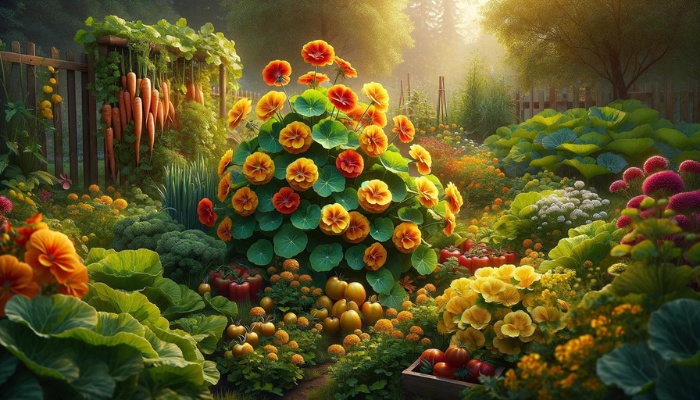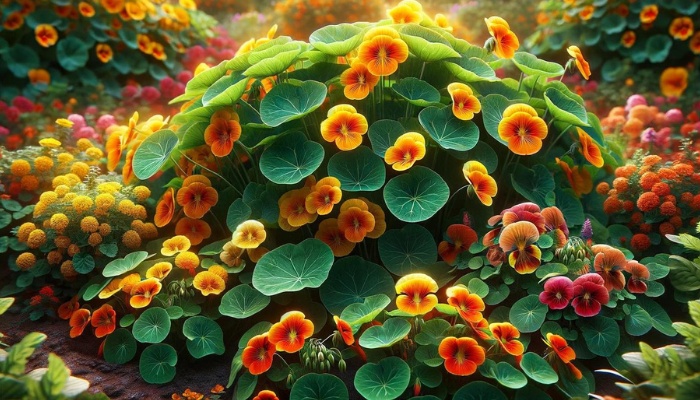Incorporating nasturtiums into your square foot garden enhances its beauty, boosts its productivity, and fortifies its health.
These vibrant plants aren’t just a feast for the eyes; they offer edible flowers and leaves that spice up salads and act as a natural pest deterrent, making them a multitasker in your gardening space.
However, understanding the nuances of planting, spacing, and caring for nasturtiums can make all the difference in their performance.
Benefits of Nasturtiums
Nasturtiums offer a multitude of benefits to your square foot garden, including acting as a natural pest deterrent and enriching the soil with vital nutrients.
They’re particularly adept at pest control, drawing aphids away from more vulnerable plants. This sacrificial role not only reduces the need for chemical pesticides but also fosters a healthier, more balanced garden ecosystem.
Also, their presence can attract beneficial insects, such as ladybugs and lacewings, which are natural predators of common garden pests.
In terms of soil improvement, nasturtiums play a significant role. They’re known for their ability to capture and utilize less accessible nutrients, effectively mobilizing them and making them available to neighboring plants.
This attribute is particularly beneficial in the compact, nutrient-dense environments of square foot gardens, where efficient use of space and resources is paramount.
Implementing nasturtiums into your garden design isn’t just about adding a splash of color; it’s a strategic decision that leverages their natural capabilities for pest control and soil improvement.
Their inclusion can lead to a more robust, self-sustaining garden, reducing your reliance on external inputs and interventions.
Choosing Your Varieties
When selecting nasturtium varieties for your square foot garden, it’s essential to consider their growth habits and flower colors to maximize both aesthetic appeal and garden functionality.
Nasturtiums, with their vibrant blooms and lush foliage, offer a range of options from trailing types that cascade beautifully over the edges to bushy varieties that fill in spaces with ease.
Here’s a concise guide to help you choose:
- Determine Growth Form: Decide between trailing, climbing, and bush varieties based on the structure of your garden and desired coverage.
- Consider Flower Colors: Nasturtiums offer a palette ranging from fiery reds to soft yellows. Select color choices that complement your garden’s theme or create a striking contrast.
- Evaluate Leaf Size: Larger leaves can provide more shade for soil, aiding in moisture retention, but smaller leaves often result in more blooms.
- Research Seed Sources: High-quality seeds ensure vigorous growth and abundant flowering. Opt for reputable seed sources that offer a wide variety of nasturtiums.
Making informed decisions about the varieties you plant will lead to a more successful and visually appealing square foot garden.
Planting and Spacing Tips

Nasturtiums, being versatile, benefit greatly from companion planting, enhancing both growth and pest resistance. They’re perfect alongside vegetables like cucumbers and tomatoes, deterring pests while promoting a healthier garden ecosystem.
For optimal growth, understanding soil requirements is essential. Nasturtiums prefer well-drained soil with moderate fertility. Overly rich soil can lead to more foliage than flowers, so aim for balance.
When planting, ensure your soil is moist but not waterlogged.
Spacing is key in a square foot gardening setup. Plant nasturtium seeds about 10 to 12 inches apart to give each plant enough room to flourish without overcrowding.
This spacing supports adequate air circulation, minimizing the risk of fungal diseases. If you’re planting multiple nasturtiums in a square foot grid, aim for one plant per square to avoid competition for resources.
Incorporate these planting and spacing tips into your gardening practice to maximize your nasturtiums’ health and productivity.
With the right approach, these vibrant flowers won’t only beautify your garden but also contribute to a balanced and productive plant community.
Care and Maintenance
Properly tending to your nasturtiums involves a series of steps designed to optimize their health and vigor. Here are the key aspects to consider:
- Watering: Nasturtiums prefer moderate watering. Ensure the soil is moist but not waterlogged as excessive moisture can lead to root rot. Water at the base to minimize leaf moisture, which can attract pests or lead to fungal diseases.
- Soil Conditions: Well-draining soil with a moderate nutrient content is ideal. High fertility can encourage more foliage than flowers. Perform a soil test, and adjust the nutrient levels if necessary, aiming for a balanced soil environment that supports healthy nasturtium growth.
- Pest Prevention: Regularly inspect your plants for common pests like aphids and caterpillars. Employ natural pest control methods, such as introducing beneficial insects or using neem oil, to maintain an organic garden and prevent infestations without harming your nasturtiums or the environment.
- Mulching: Apply a thin layer of organic mulch around your nasturtiums to conserve moisture, suppress weeds, and maintain optimal soil conditions. Avoid heavy mulching, which can retain too much moisture and negatively impact your plants.
Harvesting and Usage
Harvesting your nasturtiums requires careful timing to ensure optimal flavor and nutritional benefits from both the leaves and flowers. The best time to pick the leaves is in the morning when they’re most tender, ideally before the plant flowers.
For the flowers, wait until they fully open for the strongest taste. To maintain their freshness, immerse them in cold water immediately after harvesting, and then gently pat dry.
For long-term use, consider various drying methods. Air drying is the most straightforward technique; simply spread the leaves and flowers on a clean surface in a well-ventilated, dark area.
This method preserves their vibrant colors and essential oils, crucial for their spicy flavor. Alternatively, a food dehydrator can expedite the process, keeping a low temperature to prevent nutrient loss.
Incorporating dried nasturtiums into your culinary experiments opens a realm of possibilities. Crush the dried leaves into powder for a peppery seasoning, or use whole dried flowers to infuse oils and vinegars with a subtle spiciness.
Remember that the key to maximizing their culinary potential lies in the drying process—properly dried nasturtiums retain more flavor and nutritional value, elevating your dishes with their unique zest.

